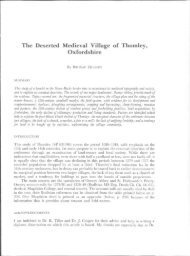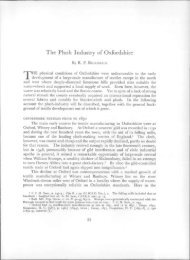Excavations at Wallingford, 1974 - Oxoniensia
Excavations at Wallingford, 1974 - Oxoniensia
Excavations at Wallingford, 1974 - Oxoniensia
Create successful ePaper yourself
Turn your PDF publications into a flip-book with our unique Google optimized e-Paper software.
206 T. J. WEARE<br />
(3 x 4'5 m. irutially, l<strong>at</strong>er extended) on the south side of the site. A system of metric<br />
coordin<strong>at</strong>ion was used to record positions in plan. Levels recorded in both trenches<br />
were referred to the same d<strong>at</strong>um, a fixed point outside the site. This d<strong>at</strong>um was<br />
reduced to Ordnance D<strong>at</strong>um through a permanent bench mark.<br />
To maintain as much control as possible each trench was divided into quadrants<br />
and excav<strong>at</strong>ion altern<strong>at</strong>ed between diagonal pairs of quadrants until a fe<strong>at</strong>ure or<br />
layer was identified.<br />
NEW ROAD<br />
18/111<br />
SCALE<br />
i.Fili I I<br />
0 2 1 ~ 5 6 7 8 9 10 Metres<br />
Tronch I<br />
....<br />
'"<br />
Q:<br />
....<br />
V}<br />
21/105<br />
Trench 1<br />
I--<br />
N<br />
\<br />
l-<br />
r<br />
V}<br />
'" l:<br />
...<br />
:to<br />
....<br />
20/100<br />
I--<br />
b~se line<br />
'0(100<br />
FtG. !2<br />
Plan of site showing position of trenches, base line, etc.<br />
Period 1.' Pre-burial phase (?twelfth/thirteenth century A.D.)<br />
Trench I. Two pits were found, each approxim<strong>at</strong>ely 1'5 m. diameter, I m. deep<br />
(one = 26 on FIG. 3).<br />
Trench II. A chalk, mortar and flint layer (230 in FIG. 4) in the south-west corner<br />
was cut by an articul<strong>at</strong>ed inhum<strong>at</strong>ion and by the Period 2 bell-pit described below.<br />
Little can be said about the trench I pits, as they were in the north·east and south-west<br />
corners of the trench and could only be partly excav<strong>at</strong>ed. It is unlikely th<strong>at</strong> they were<br />
rubbish pits because they contained very little debris, and they may have been dug to<br />
extract gravel. They pre-d<strong>at</strong>ed use of the site for burials as there were inhum<strong>at</strong>ions above<br />
them.<br />
The layer of chalk etc. in trench II is thought to have been a spread of building<br />
debris although no evidence of footings or of a robber trench was found.













